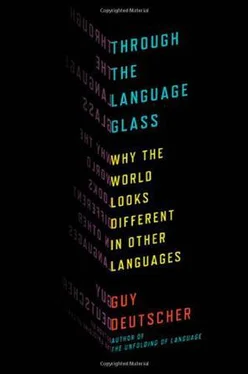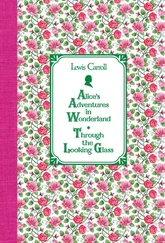
Unfortunately, Geiger’s evolutionary progression was felt to be exactly such an unwanted hangover. The hypothesis of a common order in the development of color vocabulary (black and white › red › yellow › green › blue) seemed to be committing the worst sins of the past: it placed different languages on a straight hierarchy in which the simplest cultures, with the fewest color names, were at the bottom, and European languages, with their refined and sophisticated color vocabulary, were at the top. What is worse, Geiger’s sequence inevitably made the color systems of primitive peoples appear like mere way stations on the road toward European civilization. In the new intellectual climate, such an evolutionary hierarchy was an embarrassment. And the thought that in this particular case the hierarchy might actually be true must have made the embarrassment all the more painful. The temptation to forget about it was hard to resist, and as it turned out, an excuse for doing just that was not too difficult to come by. A suggestion was made that Geiger’s sequence may have been just a coincidence: the precedence of red over yellow, for instance, may just have been an accident of the sample of languages for which information happened to be available. Perhaps when a larger number of languages were examined, so the new argument ran, some would be found to have acquired a name for yellow before red. Not that anyone did find such languages, then or later (although one aspect of Geiger’s sequence did eventually require modification, as we shall see in a moment). But merely the hope that counterexamples might crop up one day was considered a good enough reason not to bother with explaining the inconvenient parallels in the development of color vocabulary among so many unrelated languages. Geiger was thus thrown out with the dirty bathwater of nineteenth-century bigotry.
In the decades following the First World War, Geiger’s sequence was simply erased from memory, as was the whole protracted debate of the nineteenth century. All that now remained was one mantra: color vocabularies vary greatly between cultures. The deep similarities that underlie those differences no longer seemed to be worth a mention, and each culture was now claimed to carve up the spectrum entirely according to its whim. In 1933, the leading American linguist of the generation, Leonard Bloomfield, stated the now established creed with confidence: “Physicists view the color-spectrum as a continuous scale, but languages mark off different parts of this scale quite arbitrarily.” The equally eminent Danish linguist Louis Hjelmslev echoed Bloomfield a decade later, asserting that each language “arbitrarily sets its boundaries” on the spectrum. By the 1950s, the formulations became even more extreme. The American anthropologist Verne Ray declared in 1953 that “there is no such thing as a ‘natural’ division of the spectrum. The color systems of man are not based upon psychological, physiological, or anatomical factors. Each culture has taken the spectral continuum and has divided it upon a basis which is quite arbitrary.”
How could such piffle be spouted by sober scientists? Just imagine what these statements would actually mean if they were true. Suppose the color concepts of each language were really arbitrary and there was nothing natural about them at all. We could then expect that any random way of carving up the spectrum would have the same likelihood of being adopted by languages around the world. But is this the case? Let’s take a simple example. English has three color concepts, “yellow,” “green,” “blue,” that divide the relevant part of the color space roughly as shown in figure 4a.
Now, if that division were merely arbitrary, we would expect it to be no more common among the world’s languages than, say, the division into: “grellow” (green + yellow), “turquoise,” and “sapphire,” roughly as in figure 4b.
So why are there dozens of languages that do things roughly like English, and none reported with the alternative division?
If this example sounds too Anglocentric, consider a more exotic one. We have already seen that there are languages that divide the whole color space into just three concepts. If colors really were arbitrary, then one would expect that any three-way partition of the color space would be just as likely to be adopted by languages around the globe. In particular, we would expect the following two options to be found with roughly equal frequency. The first option (figure 5a) is represented by the language of Bellona, the Polynesian atoll that I mentioned earlier. The three concepts of Bellonese divide the color space as follows: “white,” which includes also all very bright colors; “black,” which also includes purple, blue, brown, and green; and “red,” which also includes orange, pink, and dark yellow. The second option (figure 5b) is said to be found in another island language with which we are also familiar. In Ziftish, the division differs from Bellonese in one important detail: green belongs with “red” rather than with “black.” In other words, the “red” concept in Ziftish includes red, orange, pink, dark yellow, and green, whereas the “black” concept includes just black, purple, blue, and brown. Now, if each culture really set the boundaries between colors “quite arbitrarily,” then we would expect the Ziftish way to be just as common as the Bellonese. So why is it that there are dozens of languages that behave like Bellonese but not a single one is known to behave like the proverbial Ziftish?
For decades such facts were considered beneath the notice of serious scholars, and the claims about the arbitrary concepts of color were promulgated unchallenged in textbooks and lecture halls. The theory of arbitrariness may have had no legs to stand on, nor bottom, nor back. But as with the chair in the ditty, the theory just sat, ignoring little things like that.

All that changed in 1969, when a little book by two researchers from Berkeley, Brent Berlin and Paul Kay, rudely interrupted half a century of blissful oblivion and reinvented the spectrum. Having sensed the absurdity of the claims about arbitrariness in color vocabulary, Berlin and Kay set out to do some systematic comparisons: they collected judgments about color names from informants in twenty different languages, using an array of colored chips as in figure 6.
Their analysis led them to two startling discoveries, and as the news of these discoveries began to spread, their book was heralded as a new dawn in the study of language, a revolutionary breakthrough, a watershed that would transform both linguistics and anthropology. One reviewer wrote: “It seems no exaggeration to claim for Berlin and Kay’s Basic Color Terms a place among the most remarkable discoveries of anthropological science.” And another added: “Only very occasionally is a discovery as ostensibly significant and important as that reported in Basic Color Terms … Either of [Berlin and Kay’s two main] findings would be startling, but attending both in a single small book is truly amazing.”
What were those two amazing findings? First, Berlin and Kay discovered that color terms were not so arbitrary after all. Although there are considerable variations between the color systems of different languages, some ways of dividing the spectrum are still far more natural than others: some are adopted by many unrelated languages while others are not adopted by any.
It was their second discovery, however, that left the academic community reeling. This was the revelation, which Berlin and Kay themselves termed a “totally unexpected finding,” that languages acquire the names for colors in a predictable order. To be more precise, Berlin and Kay discovered the sequence that Lazarus Geiger had postulated 101 years before and that in Magnus’s hands turned into the subject of intense and protracted debate in the last decades of the nineteenth century.
Читать дальше













